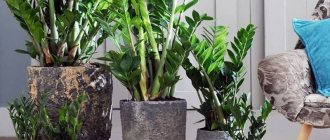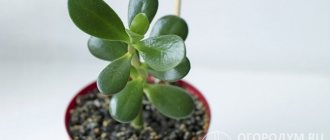Plant zamioculcas - decorative deciduous, with glossy, large, darkgreen shoots and leaves that retain color all year round. Life cycle – 5-10 years. Originally from the dry regions of Africa, this succulent capable of storing water in fleshy roots, stems and leaves.
Beautiful and evergreen plant Zamioculcas
Zamioculcas or "dollar tree"
Due to its similarity with Crassula, which we usually call the “money tree,” Zamioculcas, which is fleshier and larger, therefore looking more impressive, is called the “dollar tree.” It is believed that its cultivation as an evergreen plant guarantees the constant presence of evergreen currency.
Zamioculcas will fit perfectly into your interior
Another sign is related to the fact that at home the plant almost does not bloom - therefore, the girl who achieves its flowering is guaranteed female happiness. But since the appearance of flowers is an extremely rare phenomenon, another name “zamioculcas - flower of celibacy” has taken root. And in China it is also used as a New Year tree.
Zamioculcas flowering is an extremely rare phenomenon
- Advice! Since zamioculcas juice contains toxic substances that can cause allergies or intestinal disorders, you need to wear gloves when caring for it (cutting, replanting). Also make sure that pets and small children do not try the plant, otherwise the risk of poisoning is very high.
Due to the fact that the plant has been introduced into cultivation relatively recently (since the early 2000s), its “pure” botanical species, Zamioculcas zamiaefolia, is mainly found on sale. However, in 2007, the first hybrid already appeared - the low-growing variety Zamicro, which differs from the original type in its miniature size (it grows no more than 60 cm in height) and smaller, more graceful leaves.
Zamioculcas Zamicro
Briefly about care
Temperature - in the cold season +16º - +18º in the warm season +22º - +28º Humidity - not picky, prefers dry air
Lighting - bright but diffused light Watering - once a month in winter, once a week in summer
Soil - for cacti and succulents with the addition of perlite Feeding and fertilizer - from May to September, once a month, with fertilizer for succulents and cacti
Transplantation of zamioculcas - a young plant (up to 3 years old) annually in the spring, an adult - once every 2-4 years. Reproduction - by leaves, by dividing the bush
Temperature
Homemade zamioculcas is a heat-loving flower. And from spring to autumn, it is advisable to maintain the temperature in the room with the plant within +22...+25 degrees. Cooler conditions are allowed in winter. But it is worth remembering that the mark of +16 degrees is critical for the culture.
At any time of the year, it is also important to provide the zamioculcas with an influx of fresh air. Therefore, ventilate the room regularly, and in the summer you can even send the flower to the balcony or garden. But remember that the plant does not tolerate drafts well. Therefore, during ventilation, take the pot to another room. And when growing on a balcony or in the garden, choose closed places for zamioculcas, where there are no sharp gusts of wind.
How to care for Zamioculcas after purchase
Once you have it in your home, place it out of direct sunlight on a moderately lit windowsill or close to a window. It is better not to touch the zamioculcas at all for a week so that it gets used to the microclimate.
When purchasing from a local nursery, it is advisable to postpone the transplant for 1-2 months. If the flower feels good without replanting, then it is better to postpone it altogether until next spring.
When importing a plant from abroad, it is necessary to replant it within a week: the soil in which it is transported is unsuitable for long-term cultivation. It is most convenient to cut the flower pots when replanting to avoid damaging the roots.
Plants are often brought to us from the Netherlands. And even if you bought a buck tree at a local store, it is better to ask the seller where the nursery is located.
Daria Sumarokova, florist with 8 years of experience, author of the website “Flower, Grow”
For the first time, we water the flower only after two weeks, starting to spray it carefully. The plant could be injured and damaged, and it is necessary that all wounds have time to heal. If you decide to transplant zamioculcas, you can water it immediately.
Folk signs
It is not for nothing that Zamioculcas is also called the “dollar tree”. The flower attracts wealth into the house and is able to gift the person who cares about it with brand new green bills.
Previously, the plant was very expensive, and it was always given as a gift, wishing for prosperity. Usually such a gift is presented to the head of the family, because he is considered the main breadwinner.
But if you want the sign to work 100%, you should grow the bush yourself. Since this is a long story, you will have to wait for more than one year for wealth. True, the appearance of each new piece of paper indicates either the repayment of a debt, or a win in the lottery or any other income. If the ward begins to fade and shed its leaves, you know that financial troubles will soon break out.
Zamioculcas care: in detail
The plant does not require special care and is ideal for those gardeners who forget about their green pets and cannot pay much attention to them.
When growing zamioculcas, pay special attention to selecting the soil, maintaining the temperature regime, and allowing the soil to dry well after watering.
Also about caring for Zamioculcas in this video:
Bloom
The inflorescence reaches 3-5 cm in height and 1 cm in diameter. The Zamioculcas flower grows from the ground itself and can be so inconspicuous that it is difficult to see among the leaves. The flowering period is from April to October.
dollar tree flower
Zamioculcas blooms very rarely. Seed setting does not occur even during pollination, so it is recommended to remove the inflorescences at the beginning of flowering. Interestingly, the plant most often begins to bloom only at the end of its life. On average, it lives at home for about 10 years.
Temperature
In summer it can withstand temperatures from +22º to +28º, in winter it is advisable to move the plant to a cooler place and maintain a temperature of +16º - +18º.
In general, the plant can withstand temperatures from +12º to +38º. Zamioculcas is heat-loving and does not tolerate sudden temperature changes - it is advisable to try to maintain a stable regime.
Watering
Does not tolerate excessive watering and high humidity indoors. However, if it is overdried, its leaves may turn yellow. For irrigation, use water that has been standing for at least a day, always at room temperature.
You can water with cooled boiled water. When watering, it is important to make sure that the water goes through the entire pot. However, it is necessary to drain the water from the pan after 1-2 hours to avoid rotting of the roots. In the warm season, water once a week; in the cold season, reduce watering to once a month.
With Zamioculcas it is better not to top up than to overfill. It does not tolerate waterlogging very well.
Daria Sumarokova, amateur florist
Spraying
Zamioculcas can simply be wiped with a soft damp cloth. You can periodically give him a warm shower.
Lighting
Tolerates bright lighting and light shading; the best option for it is diffused light. When exposed to direct sunlight, burns appear on the plant. It is possible to use a phytolamp to ensure that the plant has enough light.
Where to put Zamioculcas
An east, west or southeast window is ideal. It feels good on a south window if it is darkened. It will be difficult to grow in a north window: from lack of lighting, the leaves turn pale, and the branches become elongated and thin. The room should be well ventilated, but in winter it is important to avoid drafts. In the warm season, you can take it outside or onto the balcony.
Pot for Zamioculcas
For the first time, a plastic pot is suitable, which can be easily cut without damaging the roots during replanting. In the future, it is advisable to choose a ceramic pot with a diameter 3-4 cm larger than the root system.
There must be drainage holes in the bottom. A tall, narrow pot is ideal for this flower. It's all about the characteristics of the plant: it produces new arrows only when the roots rest against the walls of the pot.
To make the flower produce new arrows faster, in the spring it can be watered with water slightly above room temperature.
Soil for dollar tree
It is advisable to purchase special soil for cacti and succulents. However, you can prepare the soil at home. To do this, mix garden soil and peat in half with the addition of perlite.
Zamioculcas is suitable for soil for cacti
When preparing the soil yourself, it is necessary within 30 minutes. bake it in the oven, or leave it in the freezer for a day to get rid of parasites and fungi. The soil should be light, well permeable to water and air.
It is not advisable to choose ready-made soil for deciduous plants: it may not be suitable for zamioculcas: such soil retains moisture better, which leads to rotting of the root system.
Does Zamioculcas need feeding?
You can fertilize the plant from May to September. We use special fertilizer for cacti and succulents, but use only a third of the amount specified in the instructions . Zamioculcas is fertilized once a month.
Cactus fertilizer is suitable for the castle
How often to replant
A castle up to three years old can be replanted as planned every spring, an adult - every 2-4 years.
To understand that it’s time to choose a new pot for an adult flower, you need to look at its roots: if they appear from the drainage holes, it’s time to think about replanting.
This is done by the transfer method: you cannot shake off the soil from the roots, otherwise you can ruin the plant.
We leave the roots sticking out of the ground a little. After transplanting, refrain from watering for 2 weeks.
Zamioculcas needs an unscheduled transplant after purchase, when the plant becomes cramped in the pots, or if it has lost its beauty: the leaves have turned yellow and began to fall off, the flower withers.
Trimming
The flower grows up to 1 m in length, so it can be trimmed to make it look presentable. This is also done to rejuvenate, propagate the plant or treat it if it is sick.
We carry out the manipulation in spring or summer. If you prune it in winter, when the plant is not growing in size, its appearance may deteriorate.
Zamioculcas grows very slowly, so there is no need to prune it in the first few years. If the purpose of pruning is to rejuvenate the plant, it is enough to remove yellowed and dry leaves. To form a beautiful crown, we thin out the young and stopped growing fragments of the leaf.
When pruning, you can get rid of entire branches, the main thing is not to cut them at the root, but to leave small stumps. The cutting areas must be dried and treated with activated carbon powder.
Important: after the procedure, do not move the plant and do not water it for a week.
Zamioculcas does not need to be shaped by pruning. After purchasing, you can immediately select a phytolamp for it, and then it will not stretch above the adjusted height.
How unpretentious is Zamioculcas?
The flower requires virtually no care, especially in winter. The less attention you pay to him at this time, the healthier and more beautiful he will grow up. During the cold season, you can safely go on vacation, leaving the plant without care even for a whole month.
Rejuvenation
Zamioculcas is rejuvenated by dividing the old large bush into several smaller ones. During this procedure, old, unsightly branches are also pruned.
When you need support
The leaves are quite heavy and the branches can fall apart under their own weight. Therefore, the plant must be tied up using a ring support, which is made of elastic tape, wood or solid wire. Young, weak branches especially need support.
To do this, we use ordinary thin sticks to which we tie zamioculcas shoots. To install a ring support, we also insert several twigs along the edge of the pot and wrap them around a ring prepared in advance so that the branches of the plant do not fall apart in different directions.
To make the plant look more aesthetically pleasing, you can build a support for it
Buck (currency, euro) tree in the interior
- According to the teachings of Feng Shui, it is best to place a pot with a Eurotree in the southeastern part of an office space or room in an apartment, so it can effectively attract financial flows into the house.
- Zamioculcas looks best on a table or stand near the window.
- You can also place the pot in the back of the room, where there is diffuse lighting for at least 6 hours a day.
You will find even more useful tips on where to place the flower, as well as photos of Zamioculcas in the interior of the apartment on this page.
Possible mistakes during care
Zamioculcas most often dies due to improperly selected soil and excessive watering. In winter, try to touch the plant less often: do not prune, do not move from place to place, reduce watering and do not feed. A flower may also lose its aesthetic appearance and stop growing due to excessively humid air and if it stands in a dark place.
Excessive watering
Yellowing and falling leaves will let you know about this. This is a sign that the roots and stem have rotted and the plant needs emergency replanting.
Lack of lighting
The flower turns pale, the branches become long and thin. To correct the situation, place the plant on a lighter windowsill or purchase a phytolamp.
Excessive dry air
Despite the fact that Zamioculcas is a succulent and loves dry air, with the beginning of the heating season it may begin to suffer from overdrying. Dry and brittle leaves will let you know about this. During this period, you can spray the plant. Another great option would be to buy a humidifier.
Improper care during the cold season
At this time, it is important for the plant not to get cold or overheat. With the arrival of cold weather, the soil does not dry out so quickly, so do not overdo it with watering: let the soil dry thoroughly to avoid rotting of the roots.
Incorrect soil composition
It is important that the soil for succulents is as light as possible, semi-sandy. It should allow air and water to pass through well.
Watering with cold water
The homeland of Zamioculcas is Africa. This is a heat-loving plant. In the spring, you can even water it with warm water (warmer than the temperature of your hand in the water), but doing this with cold water is strictly prohibited. The best option is water at room temperature that has been left standing for 24 hours.
Varieties
Most often in the collections of gardeners you can find Zamioculcas zamifolia. This is how it was named by botanists for its external resemblance to zamia, an American evergreen plant. The leaves of this variety are rich green, uniform, glossy. In large mature plants, the leaves may have dark green-purple spots closer to the base.
A much rarer, and therefore much more expensive species is Zamioculcas variegata. The leaves of this plant have a heterogeneous color, transitions from intense green to very light and even white. This effect is due to the presence of mutated cells that are unable to synthesize chlorophyll, which makes them discolored. The word “variegated” translated from English means “variegated”, “multi-colored”, so often these types of plants are also called “variegated”.
Reproduction of Zamioculcas
Zamioculcas is one of the few plants that can be propagated using leaves. Reproduction by dividing the bush is also allowed.
Reproduction of Zamioculcas by leaves
Zamioculcas is not a cheap plant; in the store it costs from 500 to 2000 rubles. Therefore, if you want to save money, you can grow it yourself.
How to grow a dollar tree from a leaf, see also in this video:
Planting a dry leaf
When using this method, roots appear within a month, after which nodules begin to form. Before planting the leaves in the soil, it is necessary that they dry out a little at the cut points. This is done to prevent the plants from rotting.
Sprinkle the prepared soil with perlite into plastic cups; you don’t have to water it; We plant the leaves broken off from the plant into the ground not very deep.
Don't worry if the leaf turns yellow. He just spent all his energy on forming the tuber.
Planting a leaf after keeping it in a glass of water
Place any leaf in a glass of water, and when it gives roots, plant it in the ground.
Rare watering should be observed to prevent the roots from rotting.
Propagation by leaf cuttings
We cut off the cutting with two leaves and plant it shallowly in the ground, after which we sprinkle a little soil on top of the place where the outer part of the cutting sticks out.
If we plant in soil recently unpacked from a bag, we don’t need to water it. If we plant it in dry conditions, then lightly moisten it. Slightly!
Reproduction by dividing the bush
- take the flower out of the pot;
- free from the substrate and separate the roots, trying not to damage them;
- cut off the damaged roots and treat the cut areas with powdered activated carbon;
- dry for 2-3 hours;
- We plant the separated plants in pots.
We leave new castles without watering for at least three days.
We divide the tubers and place them in different pots
Restrained, even meager watering
When it comes to soil moisture, it is better for zamioculcas to choose the same techniques as for cacti or succulents: the plants will withstand drought, but not dampness.
Watering the plant too much, let alone flooding it, is a sure way to problems. For Zamioculcas, water should not stagnate in trays; it is better to water the plant more often, but in moderation. The soil should dry out between these procedures not only at the top, but also partially in the middle layer. In winter, you need to monitor how the substrate dries out even more carefully.
Types of homemade Zamioculcas with photos and names
He has few varieties. They are slightly, but still different from each other, and connoisseurs will be able to choose the option they like.
Zamioculcas zamiifolia
It is distinguished by thick stems and leaves that look so beautiful that the plant can easily be confused with an artificial one.
Zamioculcas zamifolia is the most common variety
Zamioculcas zenzi (zamioculcas cv zenzi)
A compact, stocky plant with thick leaves, grows up to 60 centimeters. The variety was bred in Holland. Does not require supports.
A very unusual castle with funny thick leaves. Somewhat reminiscent of krasula (money tree)
Zamioculcas variegate
This plant variety is native to the island of Madagascar. It is almost impossible to find in local nurseries. Its distinguishing feature is its variegated leaves.
Handsome!
Zamioculcas lanceolata
It is distinguished by thin branches and elongated oblong leaves, shaped like a lancet. Reaches 1 m and above in length. His homeland is Holland.
Black zamioculcas (zamioculcas blak raven)
He is also called Raven or Raven. The stem looks a bit like a raven feather. Outwardly, he looks almost the same as other zamiki. Only its leaves are so dark that they can easily be mistaken for black. If you look at the leaf against the light, it will appear green.
Important! Young shoots are usually green and darken over time. The variety was bred in Holland, very expensive and rare.
Black zamioculcas, but young branches remain green for a while
Zamioculcas purple (zamioculcas black leave ex Korea)
A very rare and expensive variety originally from Korea. Young shoots are light green and darken over time. If you look at the leaves in the light, you can see that they have a purple tint.
Don't believe it if someone tells you that this is a compact variety. In fact, this Zamioculcas grows up to 100-120 centimeters.
Varieties
The following types of zamioculcas are grown at home:
- Zamioculcas zamifolia. The variety is valued for its compact size. And the height of a tree of this type does not exceed 60 cm.
- Variegated Zamioculcas. A species distinguished by bright green leaves with pointed tips, which are located strictly symmetrically on the stems. There are also white spots and stripes on the plates. The plant reaches up to 1.5 meters in height.
- Zamioculcas lanceolate. The variety got its name for its elongated leaves of an unusual shape. The plant reaches up to 1.5 meters in height, but there are also more compact varieties with shoots whose length does not exceed 60 cm.
- Black Zamioculcas. The variety is valued for its unusual color of leaves and cuttings. Initially they are green, but as the plants grow they darken and become almost black.
Each of these varieties will become an interior decoration. But for this you will have to make some efforts and create comfortable conditions for the plants.
Diseases and pests
Zamioculcas has good health and is rarely affected by pests. However, as a preventative measure after purchase, it can be treated with Fitoverm and Bitoxibacillin.
Root rotting
The reasons are cold, excessive watering, using the wrong water during irrigation, and water not draining from the pan.
To save the plant, you need to free the roots from the soil and get rid of the rotten ones, then disinfect them in warm water with potassium permanganate, dry them and sprinkle them with activated carbon powder. After this, zamioculcas can be transplanted into fresh soil.
Yellowing of leaves
This is a natural process. However, if new leaves do not grow after yellowing and falling, the plant may not have enough fertilizer or water.
Try to adjust the growing conditions and also use growth stimulants to solve the problem. “Agricola”, “Pokon” and “Uniflor-rost” are suitable for Zamioculcas.
Another reason for yellowing is drafts and temperature changes. In this case, remove the flower from the window and keep it away from radiators.
Yellowing leaves may indicate root rot due to overwatering. The roots must be trimmed and dried, and then planted in fresh soil.
Aphid
Black, green and gray insects are located on the back of leaves and suck the sap from plants. Spraying with special preparations will help: Fitoverm, Actellik, Aktara.
Spider mite
A red spider that can be easily spotted by its white web. It also feeds on plant sap. A warm shower will help get rid of most adult insects; special attention should be paid to the back of the leaves.
Or you can spray the plant with a spray bottle. Mites really don't like moisture.
Then the plant must be treated with insecticides: Flumite, Omite, Actellik. They will help get rid of larvae and eggs and prevent the reappearance of parasites.
Cobwebs can be found on both roots and leaves
Shchitovka
Externally they look like small rounded tubercles of yellow, brown or green color on the outer and inner sides of the leaves.
The danger of scale insects is that because of them the plant sheds its leaves and stops growing. They are easy to remove with soapy water. However, it does not give 100% results.
Therefore, it is better to use specialized chemicals: “Aktellik”, “Aktara”. To achieve maximum effect, the plant must be covered with a plastic bag for a day, and then rinsed under a warm shower. Be careful not to let harmful substances get into the soil.
There is also a universal folk remedy for pest control. 1 tbsp. Infuse tobacco in warm water, add soap and spray the leaves with the resulting substance. Leave for a day, then rinse them with clean water.
Root division
This method is quite simple, but is only suitable for adult specimens. During the next transplant, carefully divide the plant into several parts using sharp and disinfected scissors. Make sure that each piece has enough roots and 1-2 stems of the plant.
Let the cuttings air dry for 2 hours and then plant them in individual pots. The size of these flowerpots should be 2-3 cm larger than the volume of the roots. And also don’t forget to put a thick layer of drainage on the bottom of the pots. In the future, provide the flowers with regular care.
FAQ
We have collected answers to questions that are most often asked by novice zamioculcas owners
Zamioculcas grows slowly, new shoots do not appear
If you bought a plant recently, then you shouldn’t be scared: it’s just getting used to the new microclimate.
In addition, Zamioculcas grows slowly in the wild: from time to time its growth may stop altogether for some time. Provide the plant with good lighting, select a spacious but not too wide pot, maintain the temperature and do not expose it to a draft. You'll see, he will soon respond to your concern, you just need to be patient.
How to Revive a Dollar Tree
Take it out of the pot, wash and separate the roots, cut off the rotten ones, then treat them with a solution of potassium permanganate, sprinkle the cut areas with activated carbon and plant in new soil. The plant should not be watered for some time after transplantation.
What to do if a branch breaks off
Don't be afraid of this. Just cut it off at the very base and sprinkle with activated carbon, crushed into powder. A broken shoot can be used to propagate Zamioculcas.
Trimming
Pruning zamioculcas is needed to form the crown of the plant, improve its illumination, and remove yellowed, diseased or bare branches.
Using pruning, you can give the crown of a dollar tree a ball shape.
It is best to prune during the period of active growth, in spring or summer. If you do this during dormancy, winter sleep, the branches will be weak and pale, and the appearance of the plant may deteriorate.
Is it possible to keep Zamioculcas at home and why is it called the flower of celibacy?
It is unclear where the roots of this sign come from. And the superstitions themselves regarding Zamioculcas are quite contradictory. After all, along with the flower of celibacy, it is also called women's happiness.
Let's figure out why there are so many legends around zamiks.
Rarely blooms
It is believed that a woman will get married as soon as the zamioculcas blooms. However, not every flower produces an inflorescence: for this, the plant needs to create ideal conditions, and besides, it blooms towards the end of its life. On average, the plant lives up to 10 years.
Looks like spathiphyllum
In a number of sources, Zamioculcas is called the flower of celibacy because its inflorescence is similar to the spathiphyllum flower, which is supposedly a muzhegon. However, a contradiction is revealed here: on the contrary, spathiphyllum is advised to be given to girls and women in order to find happiness in their personal lives and have children.
Poisonous
Some claim that zamik is poisonous for men. The plant does contain toxins, but they are no less harmful for women than for men. To prevent the flower from harming your health, it is enough to wear protective gloves during pruning, replanting and propagation, and also keep it away from the foods you eat.
Woman's happiness
It’s absurd, but according to signs, zamioculcas can, on the contrary, attract men into a woman’s life. And all for the same reasons as to repel them: only the most caring housewife can create ideal conditions for the plant to bloom. This means you should be lucky in your personal life.
As you can see for yourself, there is little logic in such superstitions, so you should not believe them and deprive yourself of the pleasure of having an easy-to-care and at the same time charming plant at home.
The main thing is to follow safety precautions when manipulating it so as not to cause an upset stomach. And also keep the flower away from children and pets.
Medicinal properties
Like most tropical plants, Zamioculcas is poisonous. So measures should be taken to prevent pets and children from reaching the flowerpot and tearing off the leaves. If the plant juice gets inside the body, it can cause allergies.
But those who grow succulents, taking precautions, have never complained about their health. Moreover, the bush is capable of absorbing negative energy, so it makes no sense to refuse the flower.











